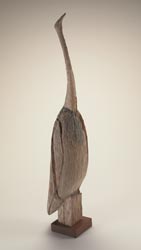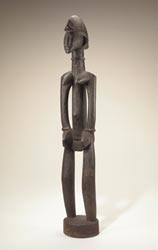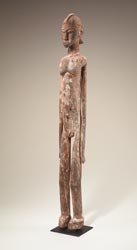Treasures marks the National Museum of African Art's 25th anniversary as a Smithsonian museum. The first in a new exhibition series, Treasuresis an old-fashioned show about African art, reminiscent of the
exhibitions that represented avant-garde opinions of the early 20th
century. In 1926, Paul Guillaume, Parisian connoisseur and collector,
cautioned readers to defer learning about the history and meaning of
African art until they had studied African art purely as an art form,
because to do otherwise "tends to obscure one's vision of the objects
as sculpture."I chose the familiar--traditional sculpture--to reveal aesthetic variances, to see African art as form, not function. Treasures,
therefore, is about visual exploration and aesthetic discovery. Our
understanding of African art is prescribed by what we see, and often,
what we see is based on works displayed in museums. So, "Treasures" is
just that--a sampling that gives us a peek into the realm of African
art.

Westerners
and Africans alike revere well-made form. Each admires skillful
technique and execution, exquisitely rendered forms, pattern, balance,
symmetry, surface treatments and a sense of completeness. African
artists, however, strive to portray more than that. As metaphor or
symbol, their artworks embody the world of ideas and
beliefs--confirming their notions about themselves, life and death, the
universe and the spiritual realm. Yet, despite our cultural
presumptions that separate art from life, often separating aesthetics
from meaning, and our ignorance of or indifference to what it means and
how it is used, African art astonishes.
An eclectic display of sculptures from East, West, Central, and southern Africa created between the 15th and 20th centuries, Treasures reflects individual choices and aesthetic preferences, mostly masks and statuary. Treasuresthe exhibition encompasses all the word denotes--rarity and value,
uniqueness and preciousness, and stylistically distinctive works.
Included are: works that have never or have seldom been exhibited in
the United States; works that have never been published; three renowned
Yoruba artists, Olowe (c. 1875‚1938), Areogun (c. 1880‚1954) and
Bamgboye (c. 1895‚1978); and works whose collection histories are
complete (e.g., the Bamum male figure and Olowe's bowl with figures) or
are historically significant.

Many of the works on exhibit in Treasureswere on view in several exhibitions that planted the seeds of abstract
modernism in the United States. Mexican artist Marius de Zayas,
Parisian Paul Guillaume and Parisian dealer Charles Ratton were not
only avid collectors of African art, but vigorous advocates for the
inclusion of African art as part of art appreciation. Their efforts
resulted in pivotal exhibitions in New York City in the early 20th
century. In 1914 Zayas convinced Alfred Steiglitz, pioneering
photographer and founder of the gallery "291," to exhibit 18 sculptures
from Guillaume's collection of African art. A year later, when Zayas
became part owner of the Modern Gallery, which was central to the
modernist movement, he organized the second, more important exhibition
of African art, African Negro Wood Sculptures. American painter
and photographer Charles Sheeler documented the works in a limited
edition folio of the same name in 1918. And, in 1935, Ratton supported
and lent 62 sculptures to the Museum of Modern Art's exhibition African Negro Art,
which with the above-mentioned exhibitions, validated African art's
position within the critical mainstream of American modernism.

Still other works on exhibit in Treasureswere owned by champions of modernism in the United States and Paris.
For instance, Ratton owned two Fang reliquary guardian figures and the
Hongwe reliquary guardian figure now in the collection of the National
Museum of African Art. Guillaume and later Ratton owned the Baule
female figure. Art patron Agnes E. Meyer purchased the Fang reliquary
guardian figure (and possibly the Kongo kneeling female figure and
child) from the Modern Gallery exhibit in 1915. Both these works were
given to the museum in 1972.
Treasures reflects the continuing tradition of exhibiting
African art as art and the important role private collectors have in
shaping our perceptions about African art. For the past 90 years,
Africa's rich repository of diverse and sophisticated forms, designs
and compositions has enhanced the art and museum worlds. By presenting
African art as an ensemble of visual delights, a trove of treasures, we
comprehend what Robert Farris Thompson terms "purity of presence." As
the Yoruba say, "Anyone who meets beauty and does not look at it will
soon be poor."
http://africa.si.edu/exhibits/treasures/text.html

